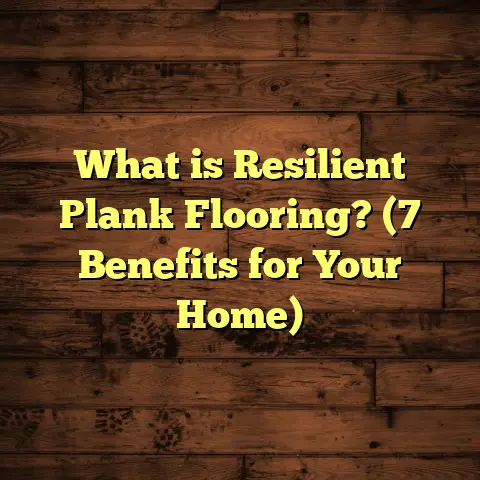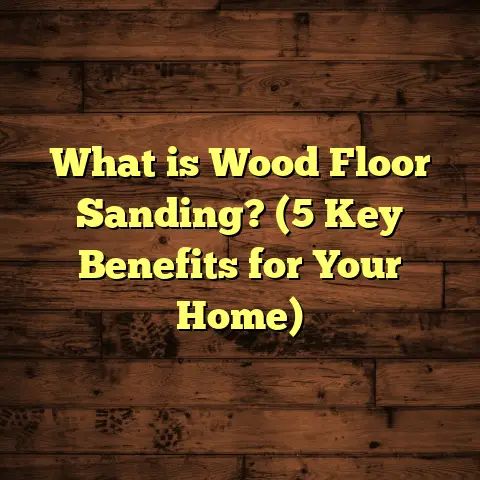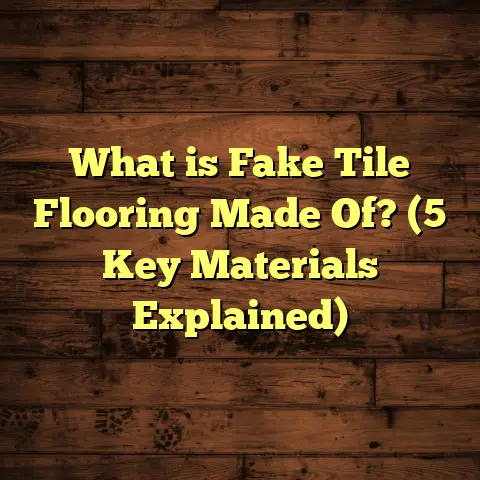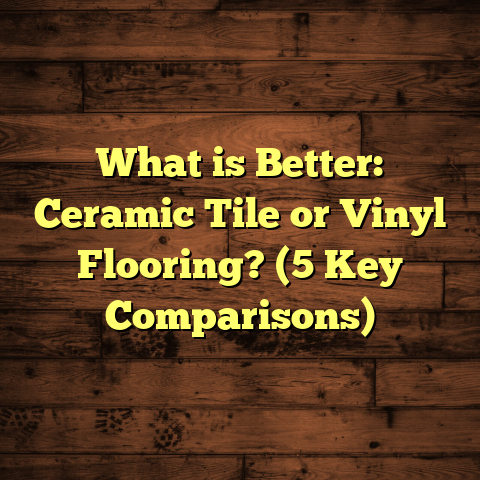What is Hardwood Solids? (5 Key Benefits for Your Home)
I still remember the first time I walked into a home with solid hardwood floors. It was an old Craftsman-style house with wide plank oak flooring that had been there for over 80 years. The moment I stepped inside, there was this warmth and richness underfoot that instantly made me feel at home. There’s something about solid hardwood that goes beyond just looks or function—it feels alive. It’s almost like the wood is telling a story of its own, with each plank carrying decades of character.
That feeling stuck with me throughout my years working as a flooring contractor. Whenever I talk about hardwood solids, it’s not just about the material or the price tag; it’s about that connection—the way the wood ages gracefully, the way it reflects light, and how it can transform a simple room into something timeless.
What Is Hardwood Solids?
Let’s get down to basics first: what exactly are hardwood solids?
Hardwood solids are planks made from a single piece of natural wood. Imagine taking a log and slicing it into thin boards—that’s your solid hardwood plank. Unlike engineered wood—which has a thin layer of real wood bonded over plywood or high-density fiberboard (HDF)—solid hardwood is 100% natural wood all the way through.
These planks typically come in thicknesses ranging from 3/8 inch to 3/4 inch (around 9.5 mm to 19 mm). The width varies too—some go for narrow strips about 2 1/4 inches wide; others prefer wider planks up to 7 inches or more. The species of wood can be anything from oak, maple, hickory, to exotic woods like Brazilian cherry or mahogany.
Here’s why that matters: because these planks are solid wood throughout, they are extremely durable and can be sanded and refinished multiple times over their lifetime. You aren’t limited by a veneer layer like engineered floors.
When I explain this to homeowners, I often say: think of solid hardwood like a classic leather jacket—something that ages beautifully and can be restored over time—versus engineered wood or laminate, which are more like synthetic fabrics that wear out faster.
The Story Behind Solid Hardwood Floors
My fascination with hardwood solids started when I was helping my grandfather restore his farmhouse. The original floors were all solid maple planks, worn down by generations of family gatherings, footsteps, and even the occasional spilled drink. Instead of replacing them with modern flooring options, we decided to sand and refinish those floors.
It was quite an ordeal—dust everywhere, hours on my knees—but when we finished, the floor looked stunning. The grain was sharper, colors deeper, and every scratch told a story rather than looked like damage.
That experience taught me something invaluable: solid hardwood floors are more than just surfaces; they’re living parts of a home’s history. That’s why many of my clients who choose hardwood solids want that same authentic feel—it’s not just about style but about legacy.
5 Key Benefits of Hardwood Solids for Your Home
1. Durability That Can Outlast Generations
One of the main reasons I advocate for solid hardwood is its unmatched durability. Because each plank is one solid piece of wood without layers, it resists warping and separation better than engineered wood or laminate.
I’ve seen floors installed in the early 1900s still holding up perfectly today. This durability isn’t just anecdotal. According to the National Wood Flooring Association (NWFA), properly maintained solid hardwood floors can last over 100 years.
What makes solid hardwood so tough? Its density and thickness play major roles. For example:
- Red oak, one of the most common species in North America, has a Janka hardness rating of 1290 (a measure of resistance to denting).
- Hickory scores even higher at around 1820.
- Exotic woods like Brazilian cherry can reach hardness levels above 2350.
For comparison:
- Engineered hardwood typically has thinner wear layers (usually 2-4 mm), limiting sanding opportunities.
- Laminate flooring uses fiberboard cores with photographic layers on top—no sanding possible.
When you have kids running around or pets scratching at doors, that durability counts.
2. Refinishing and Repair Flexibility
Another huge advantage with hardwood solids is how easily you can refinish them. Refinishing involves sanding off the surface layer to remove scratches, stains, or dents—and then applying stain and finish again.
With solid hardwood floors that are 3/4 inch thick, you can usually sand and refinish up to 8 times during their lifespan. Each sanding removes about 1/16 inch of wood.
This means if your floor gets damaged by water or heavy wear after decades, you don’t have to replace it—you can restore it instead. This is something I emphasize when discussing flooring choices with clients who want long-term value.
By contrast:
- Engineered wood floors usually have wear layers around 2-4 mm thick, allowing only one or two refinishes.
- Laminate floors can’t be refinished at all.
- Vinyl or carpet require full replacement after damage or wear.
I once worked on a project where a client’s dog scratched up an engineered floor beyond repair—replacing it was costly. If they had solid hardwood there instead, a simple sanding and refinishing would have fixed everything.
3. Unique Natural Beauty
If you care about aesthetics, solid hardwood really shines. Since it’s one continuous piece of wood, you get natural grain patterns, color variations, knots, and textures that no synthetic floor can replicate.
Each plank is unique because no two trees grow exactly the same way. This creates a warm and inviting atmosphere in any home.
Species like white oak offer subtle grain patterns with neutral tones perfect for traditional or modern styles. More rustic woods like hickory have dramatic color contrasts and knots that add character.
Personally, I love showing clients samples side-by-side so they can see how each species looks in different lighting conditions.
Also worth noting: solid hardwood takes stain beautifully if you want to customize color while keeping natural texture visible.
4. Adds Real Value to Your Home
Hardwood floors have long been associated with quality homes—and for good reason. Multiple studies suggest that homes with hardwood floors sell faster and at higher prices compared to homes without them.
According to a report by Zillow in 2022:
- Homes with hardwood floors sold for an average of 6% more than homes without.
- Hardwood floors were among the top features buyers look for.
The National Association of Realtors (NAR) also found that:
- About 75% of buyers prefer homes with hardwood or wood-look flooring.
Because solid hardwood is so durable and can be refinished multiple times, it remains an attractive feature decades after installation.
A few years ago, I helped a couple renovate their home before selling. They opted for solid oak flooring throughout the main living areas instead of carpet or laminate. When it came time to sell, their agent noted the floor was a key selling point that helped close the sale quicker—and at a premium price.
5. Healthier Indoor Environment
Indoor air quality is something many people overlook when choosing flooring materials. Carpets trap dust mites, pet dander, pollen, and other allergens—making them problematic for those with allergies or asthma.
Solid hardwood floors don’t trap allergens because they have hard surfaces that are easy to clean regularly with sweeping or vacuuming. They also don’t emit volatile organic compounds (VOCs) like some synthetic flooring materials do.
In my own home, switching from carpet to solid hardwood dramatically reduced dust accumulation and allergy symptoms for my family.
Digging Deeper: Installation Insights
Installing solid hardwood flooring isn’t a simple DIY project for most people—it requires precision and skill to ensure a long-lasting floor.
Subfloor Preparation
Before installation begins, the subfloor must be clean, dry, level, and structurally sound. Uneven subfloors can cause squeaks or even damage the wood over time.
In my experience:
- Concrete subfloors require moisture barriers.
- Plywood subfloors need to be securely fastened to prevent movement.
Skipping these steps leads to problems down the road.
Installation Methods
There are three main ways to install solid hardwood:
- Nail-down: The most common method for solid hardwood; planks are nailed directly into plywood or wooden subfloors.
- Staple-down: Similar to nail-down but uses staples; faster but less common.
- Glue-down: Often used over concrete slabs; requires special adhesives.
Each method has pros and cons depending on subfloor type and room location.
For example, I installed nail-down oak floors in a historic home renovation because it matched the traditional building methods and allowed for easier future repairs.
Acclimation Process
Wood naturally expands and contracts with humidity changes. Before installation, planks must acclimate in the installation environment for several days (typically 3-7 days).
I’ve seen projects where skipping acclimation caused gaps or buckling after installation due to moisture imbalance.
Caring for Your Hardwood Solids
Proper maintenance helps preserve beauty and durability for decades.
Daily Cleaning
- Sweep or vacuum regularly to remove dirt and grit that can scratch surfaces.
- Use soft-bristle brooms or vacuums designed for hard floors.
Deep Cleaning
Use manufacturer-recommended wood floor cleaners periodically. Avoid harsh chemicals or excessive water which can damage wood fibers.
Preventative Measures
- Use furniture pads to avoid dents.
- Place mats near entrances to trap dirt.
- Maintain indoor humidity between 35%–55% to reduce expansion/contraction issues.
I once helped a client fix cupping issues caused by extreme humidity changes after they didn’t use a humidifier during winter months in their new hardwood home.
Environmental Impact & Sustainability
Many people ask me whether solid hardwood is environmentally friendly compared to other flooring types. The answer is nuanced.
Renewable Resource
Wood is a renewable resource when harvested responsibly from well-managed forests certified by organizations like FSC (Forest Stewardship Council).
I always encourage clients to look for FSC-certified products to ensure sustainable sourcing.
Carbon Footprint
Solid wood floors store carbon dioxide absorbed during tree growth—helping offset greenhouse gas emissions somewhat.
However, transportation and manufacturing impact carbon footprint depending on location/species imported.
Longevity Factor
Because solid hardwood lasts much longer than alternatives like vinyl or laminate (which may need replacing every 10-15 years), it reduces waste over time—a key sustainability benefit.
Comparing Hardwood Solids with Other Flooring Options (In Depth)
Here’s a closer look at how solid hardwood stacks up against other popular choices:
Engineered Wood Flooring
Pros:
- More moisture resistant than solids; good for basements.
- Usually less expensive upfront.
- Easier installation (can sometimes float).
Cons:
- Limited refinishing (1-2 times).
- Thin veneer prone to scratching.
- Less lifespan compared to solids (typically 20-30 years).
I often recommend engineered when moisture is a concern but prefer solids wherever possible due to longevity.
Laminate Flooring
Pros:
- Budget-friendly.
- Easy DIY installation.
- Resistant to scratches and stains.
Cons:
- Not real wood; lacks natural look/feel.
- Cannot refinish.
- Can’t repair damaged planks easily.
Laminate works well in rental properties or temporary installations but doesn’t offer the same lasting value as solids.
Vinyl Flooring
Pros:
- Highly water resistant.
- Variety of styles including wood-look.
- Soft underfoot compared to wood/tile.
Cons:
- Synthetic material; not biodegradable.
- Lacks authentic texture/appearance.
- Can emit VOCs.
Vinyl is great for wet areas but doesn’t match aesthetics or longevity of hardwood solids.
Carpet
Pros:
- Adds softness and warmth.
- Variety of colors/textures.
Cons:
- Traps allergens/dust.
- Requires frequent replacement (5–10 years).
- Stains easily; hard to clean thoroughly.
Carpet is cozy but not suitable for allergy sufferers or those wanting low maintenance surfaces.
Real-Life Case Studies: Hardwood Solids in Action
Here are two projects I was involved in that highlight solid hardwood advantages:
Case Study 1: Century Home Restoration
A couple bought a 1920s bungalow with original maple plank floors badly scratched and worn. Instead of replacing them with laminate as originally planned:
- We sanded down the maple planks three times over two weeks.
- Applied custom stain matching historic tones.
- Added durable polyurethane finish.
Result: Floors looked brand new while preserving original character. Resale value increased by an estimated 8%. Clients said it felt like walking on history every day.
Case Study 2: Modern Family Home
For a newly-built family home:
- Installed white oak solid hardwood throughout main living areas.
- Chose wider planks (5 inches) for contemporary aesthetic.
- Finished with matte finish that hides scratches well.
After three years with kids and pets:
- Floors showed minimal wear.
- Simple annual refinishing routine planned after 10 years will restore appearance.
Clients appreciated having a floor that combined style with practicality.
Frequently Asked Questions About Hardwood Solids
Q: Can I install solid hardwood in bathrooms?
A: Generally no—solid wood doesn’t handle moisture well and can warp or cup. Engineered wood or tile are better choices there.
Q: How much does solid hardwood cost?
A: Prices vary widely depending on species and quality but expect $8–$15+ per square foot including installation in most markets.
Q: What about noise? Do hardwood floors creak?
A: Proper installation minimizes creaks but some natural noises can happen due to expansion/contraction over time—usually minor if installed correctly.
Final Reflections on Hardwood Solids
Solid hardwood flooring isn’t just another option—it’s a commitment to quality, beauty, and longevity. The way it ages gracefully while offering repairability makes it one of the smartest investments for your home’s foundation underfoot.
If you’re debating between flooring types right now, ask yourself:
- Do I want something truly authentic?
- Am I looking for decades-long durability?
- Do I value being able to refinish instead of replace?
- Will this floor fit my family’s lifestyle?
If you answered yes often enough, solid hardwood deserves serious consideration. It has been at the heart of countless homes—and mine too—for good reason.
And if you want help choosing species or finishes tailored to your home’s style and climate conditions, I’m happy to share my experience from years on the job site—because nothing beats walking barefoot on real wood beneath your feet.





